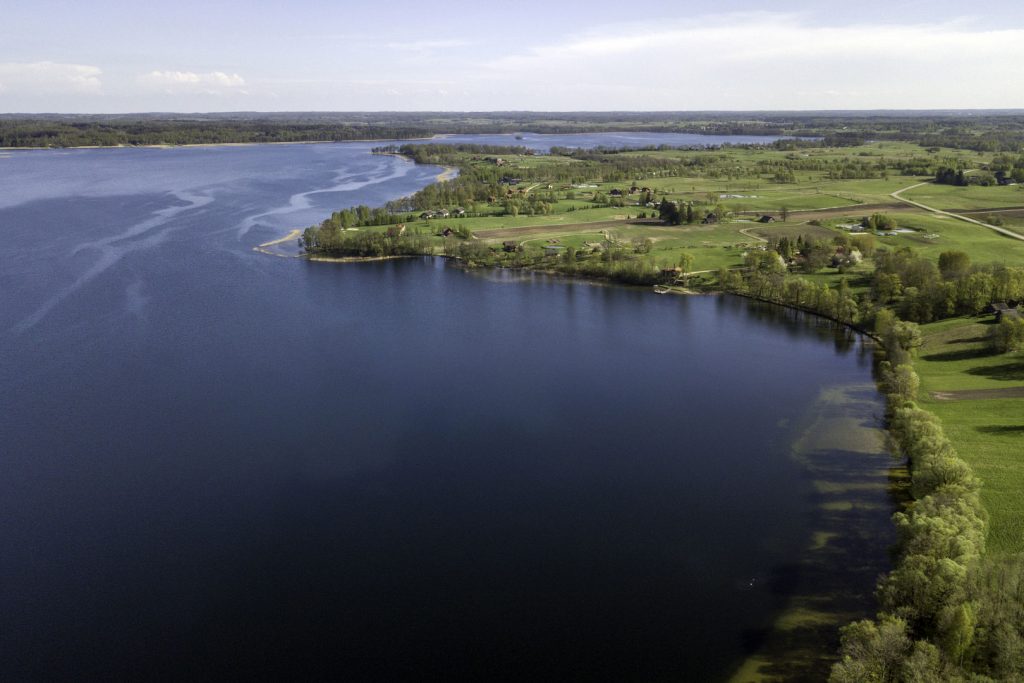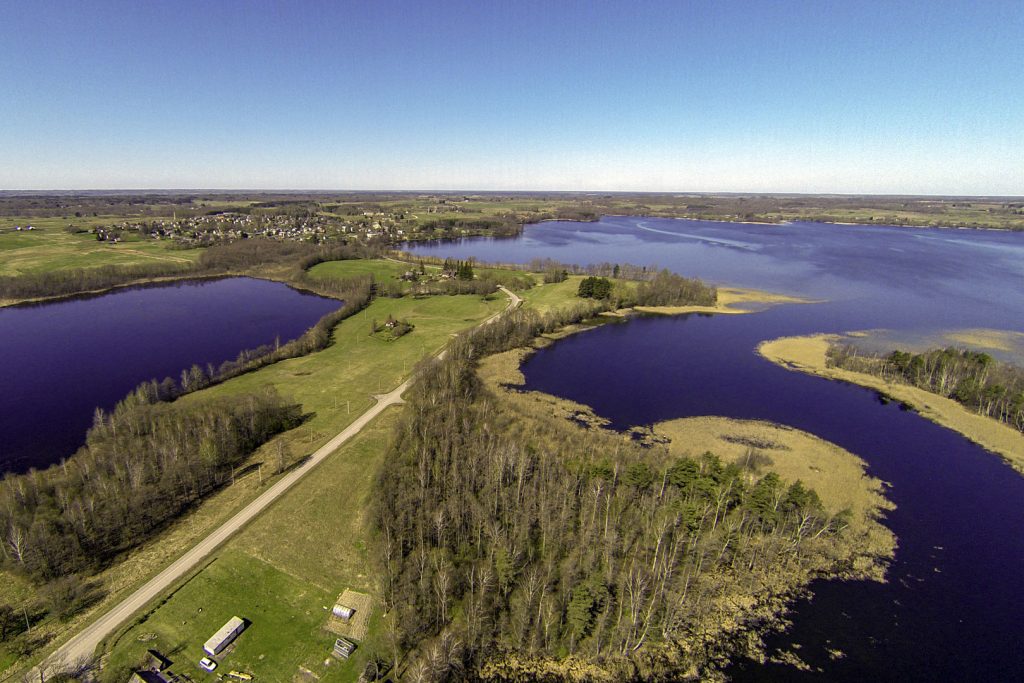Alaušas
Alaušas, situated in the territory of municipality of Utena district, is 10 km northeast of Utena. Area 1054 hectares. Length 5.9 km, the greatest width 2.7 km. The altitude 138.2 m. The greatest depth 42 m, average depth 11.9 m. The basin of Alaušas is made up of two widened glacial troughs. The area of the basin is 51.7 km2. The coastline is winding, its length 22 km. The north-western bank is high, steep, the eastern bank is lower and the western bank is flat and loamy. The bank sides are dry, wet only at the mouths of the rivulets. There are 2 islands (5.3 ha). In the south Alaušas links with lake Juodlankis by a wide channel. Rivulets of Alksnaitė (from Alksnas lake), Šiekštelė (from Šiekštys lake), Giedrė (from Giedrys lake) and two more flow into the lake. From the northern part Alauša flows out (a left inflow of the river Šventoji). The sandbank is wide, sandy, overgrown with continuous band of vegetation (especially wide in the east). On the southern bank of Alaušas there is the town of Sudeikiai.
In June, 2009 in Alaušas lake 33 species of algae were found, the biomass of phytoplankton amounted to 2.18 mg/l – this indicator proves that this is a mesotrophic lake. The level of trophicity is also confirmed by studies of zooplankton. According to the data from 1975, the biomass of zooplankton was on average 0.7 g/m3 (in winter – 0.2, in spring – 0.4, in summer – 1.0 g/m3). According to the quantitative and qualitative composition of zoobenthos Alaušas is assigned to highly nutritious (mesotrophic) lakes.
According to the data from 1975, the basis of commercial fishing then was vendace (60.9 %) and pikes (14.2 %). Average annual production of commercial fishing amounted to 5.1 kg/ha.
Alaušas is the largest and deepest lake in Utena district with vendace. There live ones of the smallest vendace, that is why 30-40 years ago it was allowed to catch vendace with nets with very small mesh (16 mm), i.e. only fish of hardly 25-35 g. Vendace in Alaušas are assigned to a slowly growing group. During a year they grow 11.05 cm, in two years – 14.27 cm and in three years – 15.6 cm. long. Female vendace of over 2 years of age reach 29.70 g of weight, males 28.50 g. In the group over 3 years of age females reached only 32.00 g of weight.
Catches using nets of various mesh showed that in the deep part of the lake roach predominate, which make up nearly 60 % of the total abundance, and over 60 % of the total biomass. The number of basses is twice as few, and other kinds of fish are rare, they are accidental. The estimated biomass of roach amounted even to 178 kg/ha, and that of basses – 143.5 kg/ha. It is difficult to say if roach come to this part of the lake searching for food or temporarily. However, there is no doubt that such abundance of them shows that commercial fishery using tools for catching vendace does not have any impact. This is also confirmed by the abundance of basses.
Relative abundance of fish and biomass of catches in Alaušas are of bass (47.6 and 60.9 % respectively). There are very few other fish in this part of the lake; they are as secondary species. Here the depth of water suitable for vendace is 15 m, so the total abundance and biomass of vendace are considerably bigger (1163 pcs. /ha and 33 kg/ha respectively). This corresponds to the most productive indicators of vendace lakes.
Abundance of fish and biomass for one unit of area are the largest of bass (nearly 60 kg/ha and over 50 pcs. /ha). There are much fewer other species of fish, only biomass of roach makes up a little more than 30 kg/ha. In the depth there live fish characteristic also to the coastline – tench, rudd and bream. Breams have not been caught with nets used for studies because of exceptionally clear water.
During the studies in 2013, 9 species of fish were caught in Alaušas lake: roach, bream, tench, rudd, vendace, ruff, bass and pike. The greatest abundance was that of ruff, roach and vendace (24.1, 22.5 and 18.7 % respectively); the largest biomass was that of bass (29.2 %), and of ruff only 9.5 % of the total biomass of fish. Nevertheless, it is quite a high percentage and thus ruff in Alaušas is a subdominant species. The fish population near the coastline is unbalanced since the number of predatory pikes makes up only 2 %. Near the coastline of up to 5-6 m deep there are very few pikes despite the fact that the lake is constantly stocked with them. It could be stated that pikes in this lake where underwater hunting is allowed are overfished. The role of predators is assumed by big basses.
According to summarized research data, dominant species in the depth of the lake are vendace and ruff, and in the vicinity of the coastline up to 5m deep, bass. Biomass of roach and rudd was slightly smaller. There could be more tench in the lake, but most probably underwater hunting reduces the source of this fish foremost. Amateur fishing, and especially underwater hunting first of all affects the fish hiding during the day (tench, eel) or predatory ones (pike).
The growth rates of roach in Alaušas are good, the average length of bass of 7+ years of age is 20.3 cm and weight 86 g – according to the length, the growth rates are average, according to the weight, slow. Not many breams were caught and not of all length categories; according to the regression line, it was estimated that breams grow very well what concerns their length, and well concerning their weight.
Lake Alaušas is the fishiest not only in Utena district, but also in the country. The total fishiness reaches 65 kg/ha of the total area of the lake, abundance of fish – 1.5 thousand pcs. /ha. However, resources of some fish are used too intensively, so restorative (supportive) stocking is necessary. Estimates for stocking should be done not for the whole lake, but for the area suitable for fish stocked. Thus the area suitable for pikes is no larger than 400 ha, for tench – 300, and for eel – 500 ha.
For bream natural spawning is sufficient, but since areas for spawning have reduced because of algae and reed overgrowth, installation of artificial spawning grounds should increase their numbers. The project of installation of artificial spawning grounds and monitoring, started in 2013, could be an example of application of long-term measures.
Artificial spawning grounds in Alaušas lake
On the bank of Alaušas lake there is Utena diving club which teaches all those wishing to dive in the lake and to comprehensively learn about it.
In 2013 the club implemented the project in Alaušas lake: „Conservation and restoration of fish stocks in Alaušas lake by installing artificial spawning grounds and quality improvement of water by biological cleaning means.“ The main objective set was to create maximum favorable conditions for natural spawning of fish.
During fish spawning in early spring in natural spawning grounds in many water bodies in Lithuania there are not enough natural plants suitable for fish eggs to stick on and hold because of fertilization and holding of fertilized eggs till splitting of larvae. It often happens that just released fish eggs, very often not being even fertilized, settle down on algae on the bottom in cold water and perish without becoming fish larvae. With the goal to create more favorable conditions for natural spawning of fish, natural fish spawning grounds were produced and lowered into the lake. Alaušas is famous for its small but very tasty vendace. The other well-known and earlier abundant species is bass, which is rapidly disappearing because of algae. So artificial spawning grounds are meant for creation more favorable natural spawning conditions for bass spawning in Alaušas lake.
Spawning of bass takes place early in spring when ice on the lake melts. During the thaw spawning bass females release eggs stuck in garlands. Then such formations descend on plants that survive after winter and stick to them, and because there are not many of them and they are scattered, very often not fertilized eggs descent on algae on the bottom and potential offsprings are doomed to perish.
Special sponges were made for fish eggs to stick on. Their purpose: to hold fish eggs released during spawning till fertilization and larvae splitting. All in all, 4250 pieces of artificial water plant replacements were installed – sponges for fish eggs to stick on.
When spawning grounds are collected and lowered into the water during night divings (at night fish move and feed more, are less shy and therefore are better to observe), a lot of fish were seen in modules of artificial spawning grounds. That was very good news. It was concluded that the materials chosen for manufacturing artificial spawning grounds and production technology were appropriate. By using anchors (weights) and buoyancy aids, spawning grounds can be installed in the appropriate depth. This is especially important so that the depth of artificial spawning grounds can be chosen according to biological needs of species of spawning fish without bigger problems.










